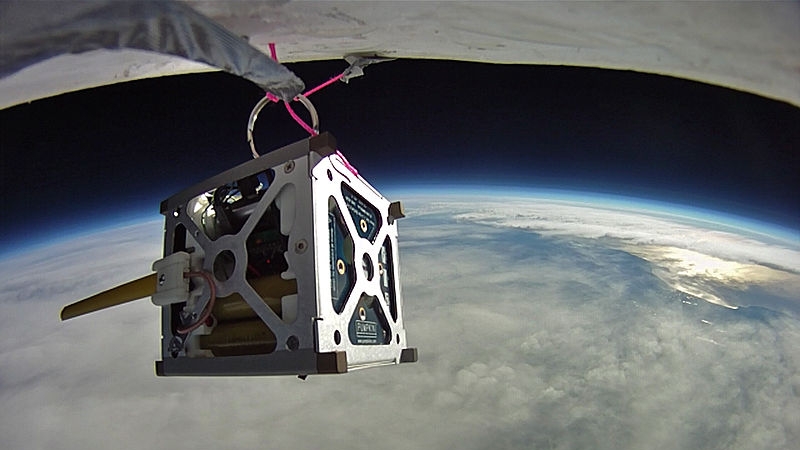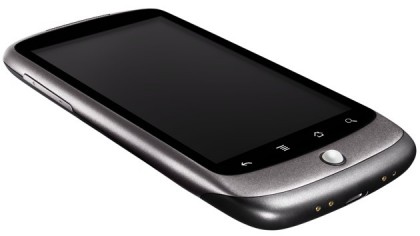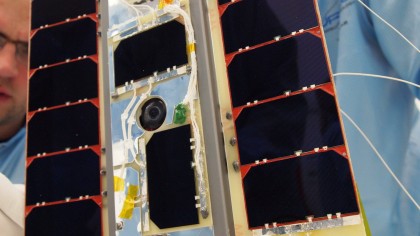Forget waterproof phones: could your smartphone survive in space?
Well, Samsung DID call it the Galaxy...

It's an age-old question, one that has troubled scholars almost as much as whether cats can count. But it's a question which we finally aim to answer: can a smartphone survive a trip into orbit?
Firstly, let's get the obvious out of the way: no, a smartphone can't make or receive calls in space, as it's reliant on ground-based antennas.
So you can't use it as a phone, but what we want to know is whether a smartphone would still work after being left floating in space or whether that harsh, alien environment would prove too much for a device that sometimes can't survive a little water or falling off a table.

Satellite phone
You may be surprised to learn that it's already been put to the test, sort of. Surrey Satellite Technology Limited (SSTL) launched a Nexus One into space in 2013 as part of a nano-satellite called STRaND-1.
The nano-satellite didn't just consist of a Nexus One, but the phone was mounted to one of the satellite's panels and sent into space in its entirety. While in space a number of apps were run from the phone, to collect data and for the fun of it, and the handset's camera was used to take pictures.
NASA has a similar ongoing project called PhoneSat, which initially involved launching a satellite with a Nexus One as its onboard computer and then launching a second satellite with a Nexus S.

You might think that answers the question, but it's a bit more complicated than that, as the satellites contained precautions to protect the phones. For example, the onboard computer on STRaND-1 would monitor the temperature of the battery and if it started getting too cold a processor-intensive programme would be triggered to warm it up.
Sign up for breaking news, reviews, opinion, top tech deals, and more.
The phones were also largely enclosed by the satellites, giving them a certain amount of protection. It's a good start, but it still doesn't tell us whether a smartphone could survive unassisted.
Hot and cold
Space can get as cold as -270.4 degrees Celsius, while being in direct sunlight in high Earth orbit can lead to temperatures of 120 degrees Celsius.
Phones just aren't built to withstand such conditions, which is understandable, since diving into a volcano followed by a trek across the Arctic isn't the kind of temperature change an iPhone is expected to encounter on Earth.

Even within comparatively normal temperatures, many smartphones don't fare brilliantly. For example, Apple reports that the iPhone 6 can withstand temperatures between 0 and 35 degrees Celsius when turned on, and between -20 and 45 degrees Celsius when off. This is nowhere near the extremes you'd potentially encounter in space.
Some phones are more resilient, but in a temperature resilience test of 15 popular smartphones carried out by TechHive in 2012, all of them shut down by -35 degrees Celsius.
Even a phone designed specifically to be durable and withstand the elements, like the Cat B15, can only be operated at between -20 and 55 degrees Celsius.

Despite this, Samsung has pushed the boat out with the Samsung Galaxy S6 Active, which meets the Mil-STD-810G standard, including support for operating temperatures of between -10 and 55 degrees Celsius and storage temperatures of between -51 and 71 degrees Celsius.
This is an exception. Most handsets aren't even close to that standard and smartphone screens may malfunction in extreme temperatures. If it's cold enough there's even a chance the screen could shatter. Gorilla Glass has made our screens stronger, but they're still not immune to the elements.

The bigger problem, though, is a phone's battery. If it gets too hot it will degrade quickly, too cold and it will drain rapidly, and at extreme temperatures the electrolyte in the battery could ignite.
So whether hot or cold, both conditions can potentially cause a phone to shut down or break altogether.
Random radiation events
But it's not as simple as the phone being hot or cold. Rather than being at a fixed orientation, it's likely to be tumbling, exposing each side to the heat of the sun and the stark reaches of space, though this means it could fare better as it wouldn't have time to reach either temperature extreme.
Dr Malcolm Macdonald, Associate Director of the Advanced Space Concepts Laboratory at the University of Strathclyde, explained: "The temperature of the phone would depend on a range of factors including its construction (emissivity and absorption) and whether it was turned on.
"I think we can assume the phone is slightly more emissive than absorptive and if you assumed the phone is tumbling, rather than in a fixed orientation with respect to the Sun, then I'd expect the temperature to be close to the lower ends of any quoted operational temperature range, but probably above the survival limit so it would probably work once it had warmed up again.
"The battery would be the primary concern as this will likely get too cold, certainly for 'optimal' performance and may even cause a leak or burst, but it might work once the phone had warmed up.
"If the phone is operating then that might be enough to keep everything warm enough. But then of course you have the increased chance of failure from random radiation events."
Risk of rays
Speaking of radiation events, cosmic rays can wreak havoc on electronic integrated circuits by altering the states of the elements in them.
This can lead to errors, corrupted data and incorrect performance of CPUs. Cosmic rays can occasionally cause problems for electronics on Earth, but out in space they're a very real threat, so a phone would ideally need shielding if turned on.
Of course a simple solution is just to turn the phone off. Macdonald explained that "leaving electronics turned off makes them 'harder' against the space environment, i.e. single event upsets, bit-flips, latch-up, etc.
"Failure rates are as much as 80% reduced compared to when they are turned on, so the electronics are more likely to work if it is switched off, but it will be subject to lower temperatures, as the on-board power consumption will, in-effect, provide an on-board heater."
Assisted living
So could a phone survive in space? Sure, but it would need some help. Inside the International Space Station or a shuttle where it's not subject to the harshness of space it wouldn't have a problem and indeed astronauts are known to take phones with them.
A smartphone can even fare pretty well as part of a satellite if STRaND-1 and PhoneSat are anything to go by.
But without certain protections and precautions it would be subject to a lot of hazards, and leaving it turned off would probably give it its best chance overall.
Still, while you're not likely to find astronauts using smartphones to take photos of a quick game of space cricket they may have a real future as the brains of satellites.

The STRaND-1 and PhoneSat tests were in large part carried out to see if smartphones could function in that capacity because they usually have faster CPUs and more memory than conventional satellites. As they're mass produced they're also a lot cheaper than a typical satellite computer, making them an appealing alternative.
If projects like this continue, smartphones may soon be giving us an eye on the solar system, and even in their current, fragile form, smartphones could potentially fare far better in space than you might imagine.
The temperatures and radiation would likely stop the phone from working properly, but if the phone was then retrieved and returned to a normal temperature it might still work - though sending up a rocket just to reclaim the Samsung Galaxy S6 you forgot probably isn't worth the cost.
- NASA's involvement with Google goes beyond sending phones into space.
James is a freelance phones, tablets and wearables writer and sub-editor at TechRadar. He has a love for everything ‘smart’, from watches to lights, and can often be found arguing with AI assistants or drowning in the latest apps. James also contributes to 3G.co.uk, 4G.co.uk and 5G.co.uk and has written for T3, Digital Camera World, Clarity Media and others, with work on the web, in print and on TV.